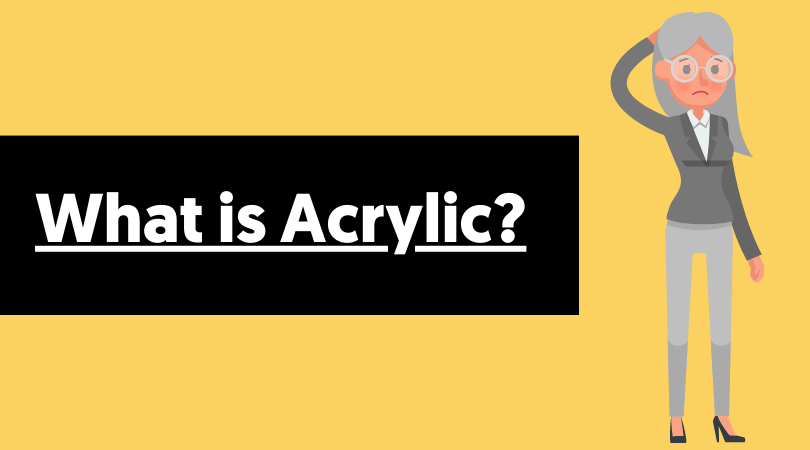Greetings everyone! Today, we will clarify a common source of confusion for plastic aficionados regarding the distinction between plexiglass and acrylic. Are they the same thing? Does plexiglass equate to acrylic and vice versa? These inquiries are frequently raised in discussions. So, let’s not delay and dive into the topic.
Plexiglass vs Acrylic
The primary difference between plexiglass and acrylic is that there is no disparity between the two. Acrylic commonly refers to polymethyl methacrylate, and Plexiglass is a prominent brand name for identical plastic. As time progressed, “Plexiglass” evolved to be synonymous with acrylic.
Plexiglass Vs. Acrylic has been a question around for a long time. Many people ask me the difference between Plexiglass and acrylic, and I give the same answer to everyone they’re almost the same and have no significant differences (except for a few).
Acrylic is a common abbreviation for polymethyl methacrylate, and Plexiglass is one of the famous brand names for this plastic. Over time the brand name “plexiglass” has become a generic name for acrylic.
There are notable differences between the two. So, without further ado, let’s understand what makes them different and similar.
What is Acrylic?

Polymethyl methacrylate (PMMA), commonly called acrylic, is a thermoplastic material celebrated for its exceptional mechanical and optical properties. These include outstanding tensile strength, density, and unparalleled optical transparency. It has garnered recognition as a high-quality substitute for traditional glass materials due to its superior impact resistance.
In addition to its most commonly known applications as a glass replacement, acrylic is versatile enough to be used in many other contexts. These range from medical instruments and optical lenses to coatings and paints.
It also finds utility in constructing security enclosures, liquid crystal display (LCD) screens, and a wide array of furniture designs. In a head-to-head comparison with glass, several attributes of acrylic come to the forefront.
While glass is universally available, economical, and amenable to recycling, acrylic offers unique advantages unmatched by glass. Among these advantages are its heightened resistance to impact, superior shatter-resistant properties, and resilience against weathering conditions. Additionally, acrylic demonstrates significant resistance to UV light and a broad range of chemical solvents.
It also possesses excellent dimensional stability, making it ideal for applications requiring precise measurements and tolerances.
Tracing the history of acrylic, its production was initiated in the 1930s, with commercial marketing beginning in 1936 under the aegis of Rohm and Haas, an American corporation.
The raw materials involved in the production of acrylic include hydrogen cyanide, sulphuric acid, methanol, and acetone. While each of these substances presents safety concerns, it’s important to note that the final acrylic product is benign and poses no health risks.
Interesting Read – Plastics Vs. Polymers
What is Plexiglass?

Plexiglass, often considered a generic term used interchangeably with acrylic, represents transparent acrylic sheeting. It is worth mentioning that the name “Plexiglass,” spelled with double “ss,” is a catch-all designation encompassing several products made under various brand names, including the original trademarked term, “Plexiglas,” without the extra ‘s.’ Historically, the first iteration of this acrylic material that came into existence during the 1930s was commercialized under the brand name Plexiglas.
While Plexiglass possesses properties that are largely comparable to those of acrylic, it’s important to note its relative vulnerability to high temperatures. This susceptibility to heat renders it unsuitable for use in safety-critical applications that demand heat resistance.
Despite this limitation, Plexiglass is frequently chosen for specific purposes owing to its unique attributes, such as lightweight structure, mechanical strength, and structural rigidity, all at a comparatively reasonable price point.
One common application is its use in glazing expansive surfaces, particularly those of noise barriers and windscreens. The material’s inherent stability and rigidity make it an excellent selection for constructing large aquariums and swimming pools.
What Are The Differences Between Acrylic vs Plexiglass?

Indeed, while Plexiglas, plexiglass, and acrylic are often used interchangeably, they have nuanced differences that stem primarily from their manufacturing processes. Essentially, these materials are versions of the same fundamental compound, differing chiefly in their production methods: extrusion and cell casting.
Extruded acrylic is crafted via a continuous extrusion technique. In this approach, raw acrylic material is fed through an extruder, where it is melted and subsequently pressed into sheets.
These sheets are cooled and cut to the desired dimensions. While extruded acrylic offers the advantages of lower production cost and high throughput, it generally falls short when it comes to mechanical properties like durability and rigidity. Contrastingly, cell-cast acrylic, often marketed as Plexiglas or plexiglass, is made using more labor- and equipment-intensive methods known as cell casting.
In this procedure, a liquid acrylic monomer is poured between two glass plates to form a ‘cell,’ which is then subject to polymerization.
Once the reaction is complete and the acrylic is fully polymerized, the sheets are detached and subjected to rigorous quality checks. This method incurs higher costs in terms of labor and equipment, which are reflected in the product’s price.
However, cell-cast acrylic exhibits superior mechanical attributes, including enhanced durability, rigidity, and quality. Given your focus on acquiring only the best, meticulously designed products, you’d likely find the extra investment in cell-cast acrylic or Plexiglas entirely justified.
The material offers advanced features and is typically higher quality, aligning well with your preference for products manufactured through more refined, albeit costly, processes.
Plexiglass vs acrylic is only the same material with some differences in properties and manufacturing methods.
Fascinating Read – LDPE Vs HDPE: What are the Differences and Similarities
FAQs
Below are the frequently asked questions about acrylic vs plexiglass. Let’s dig deep to know more.
Is there a cheaper alternative to Plexiglass roofing?
Plexiglass roofing is expensive but comes with substantial benefits that are difficult to overlook; however, if you’re still looking for an inexpensive option, you should cover your roof with flexible greenhouse plastic film. It will last under the sun for a reasonable amount of time and is the cheapest way for someone to cover their roofs.
Can you drill Plexiglass?
It is possible to drill Plexiglass with regular meal drill bits. However, certain things need to be taken care of. First of all, you need to go soft and take a breather once in a while, you can’t be hard at it like metal, or there can be casualties like melting, chipping, and breaking. Stop often to cool the drill and always give some form of support to the sheet.
What are some advantages of Plexiglass?
The disadvantages of Plexiglass are as follows:-
- Lighter, but stronger
- Easy to maintain
- Easy to process and shape
- Oustanding shatter resistance
- Durability
- Good erosion resistance
What are some disadvantages of Plexiglass?
The disadvantages of Plexiglassare as follows:-
- It scatches more often than glass.
- Distortion. Easily bend during construction.
- Easily stained by oils and greases. However, cleaning it is also very easy.
- Weak matter resistance.
What is the melting point of acrylic plastic?
160°C (320°F).
Suggested Read
- HDPE VS PVC | The Complete Guide
- What is Biodegradable Plastic? | Types of Biodegradable Plastics | Biodegradable Vs. Compostable | Properties | Applications of Biodegradable Products
- Top 10 High Impact Resistant Plastics
Final Thoughts
That was all I had to say about Plexiglass vs acrylic. The confusion surrounding plexiglass and acrylic is quickly resolved when we recognize that they are the same material. Acrylic is the general term for polymethyl methacrylate, while Plexiglass is a famous brand name. Understanding this relationship allows plastic enthusiasts to use both words confidently and focus on this versatile material’s unique properties and applications.
Kindly share your thoughts and reviews about the article in the comment box.
Have a phenomenal day.
Quick Navigation


I have to replace 2 glass panels on either side of my front door. The front gets very hot (Houston, TX) and sometimes very cold. 6.5’ high, 16” wide. Which one should I get?